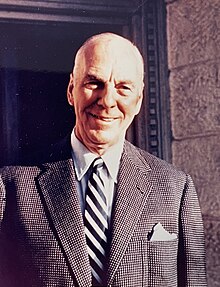| DeWitt Wallace | |
|---|---|
 | |
| Born | William Roy Dewitt Wallace November 12, 1889 Saint Paul, Minnesota, United States |
| Died | March 30, 1981 (aged 91) |
| Alma mater | Macalester College University of California, Berkeley |
| Occupation | Publisher |
| Known for | Co-founder of Reader's Digest |
| Spouse | Lila Bell Wallace |
| Parent(s) | James Wallace and Janet Wallace |
William Roy DeWitt Wallace (/dəˈwɪt/ də-WIT; November 12, 1889 – March 30, 1981), publishing as DeWitt Wallace, was an American magazine publisher.
Wallace co-founded Reader's Digest with his wife Lila Bell Wallace, publishing the first issue in 1922.
Life and career
Born in St. Paul, Minnesota, where his father was on the faculty (and later president) of Macalester College, he attended Mount Hermon School as a youth (now Northfield Mount Hermon School). Wallace attended college at Macalester from 1907 to 1909 and transferred to the University of California, Berkeley for two years. He returned to St. Paul in 1912 and was hired by a publishing firm specializing in farming literature.

During World War I, Wallace enlisted in the U.S. Army and was wounded. He spent four months in a French hospital recovering from his injuries, passing the time by reading American magazines.
Returning to the U.S., Wallace spent every day of the next six months at the Minneapolis Public Library researching and condensing magazine articles. He wanted to create a magazine with articles on a wide variety of subjects, abridged so that each could be easily read. Wallace showed his sample magazine to Lila Bell Acheson, sister of an old college friend, Barclay Acheson, who responded enthusiastically. He proposed to her and on October 15, 1921, they were married.
The Wallaces decided to publish the magazine themselves and market it by direct mail. The first issue appeared on February 5, 1922. Reader's Digest soon became one of the most widely circulated periodicals in the world. Wallace was a supporter of the Republican Party with strong anti-communist views, and the magazine reflected these beliefs. Wallace and his wife were strong supporters of Richard Nixon's presidential bid in 1968, giving Nixon cash donations and allowing Nixon to write articles for the Digest.
Wallace was a noted philanthropist, donating much of his massive fortune to his alma mater Macalester College. The Wallaces also established a number of foundations that are now consolidated as The Wallace Foundation, which supports education, youth development and the arts. There is a dormitory with his name on the Northfield Mount Hermon campus. He funded the DeWitt Wallace Decorative Arts Museum, opened in 1985 at Colonial Williamsburg, Virginia.
On January 28, 1972, DeWitt Wallace was presented with the Presidential Medal of Freedom by President Richard Nixon.
Wallace was inducted into the Junior Achievement U.S. Business Hall of Fame in 1980.
Wallace died at his home in Mount Kisco, New York, on March 30, 1981. He left no children with his wife Lila. His niece, Julia Acheson, was married to The New York Times executive Fred D. Thompson.
Awards and honors
- Golden Plate Award of the American Academy of Achievement (1966)
- Presidential Medal of Freedom (1972)
- Junior Achievement U.S. Business Hall of Fame (1980)
See also
References
- "The Story of DeWitt Wallace: An Original Aggregator - Dewitt Wallace Center". Dewitt Wallace Center. Retrieved 2017-06-01.
- "Dr. Barclay Acheson, Editor, Dies at 70; International Reader's Digest Official". The New York Times. Retrieved 2022-07-23.
- "The Story of DeWitt Wallace: An Original Aggregator". DeWitt Wallace Center. Retrieved 2022-07-23.
- "Three other publishers also enlisted in the anti-Communist ranks: Henry Luce (Time, Life), Robert McCormick, (Chicago Tribune), and DeWitt Wallace (Reader's Digest)." Larry Ceplair, Anti-Communism in Twentieth-century America: a critical history Santa Barbara, California: Praeger, 2011, ISBN 9781440800481 (p. 43).
- "The Digest's editor, DeWitt Wallace, who shared the anti-union, anti-Communist views of Lorimer and his successors, searched for ways to convey those views in positive terms". Anne Loftis, Witnesses To The Struggle: Imaging the 1930s California Labor Movement. Reno, Nevada: University of Nevada Press, 1998. ISBN 0874174406 (p. 156)
- John Heidenry, Theirs Was the Kingdom: Lila and DeWitt Wallace and the Story of the Reader's Digest, New York, W.W. Norton, 1993
- "...Lila and DeWitt Wallace chipped in $8,500, although their most important contribution was space for Nixon to pontificate in their magazine, Reader's Digest, the most widely read monthly in America." Quoted in Perlstein, Rick (2008). Nixonland: The Rise of a President and the Fracturing of America. Simon and Schuster. p. 85. ISBN 978-0-7432-4302-5.
- "About Wallace: A Brief History". The Wallace Foundation. 2019.
- "MISS JULIA ACHESON IS BETROTHED HERE; Niece of Editor Will Be Wed to Frederick D. Thompson Jr". The New York Times. 1938-12-31. ISSN 0362-4331. Retrieved 2022-07-23.
- "Golden Plate Awardees of the American Academy of Achievement". www.achievement.org. American Academy of Achievement.
External links
| Colonial Williamsburg | |
|---|---|
| History | |
| Structures |
|
| People | |
| Geography | |
| Other | |
- 1890 births
- 1981 deaths
- Businesspeople from Saint Paul, Minnesota
- Military personnel from Minnesota
- American magazine founders
- American magazine publishers (people)
- Northfield Mount Hermon School alumni
- Reader's Digest
- People from Mount Pleasant, New York
- Philanthropists from New York (state)
- United States Army personnel of World War I
- Macalester College alumni
- Presidential Medal of Freedom recipients
- Minnesota Republicans
- 20th-century American philanthropists
- 20th-century American businesspeople
- American anti-communists
- New Right (United States)